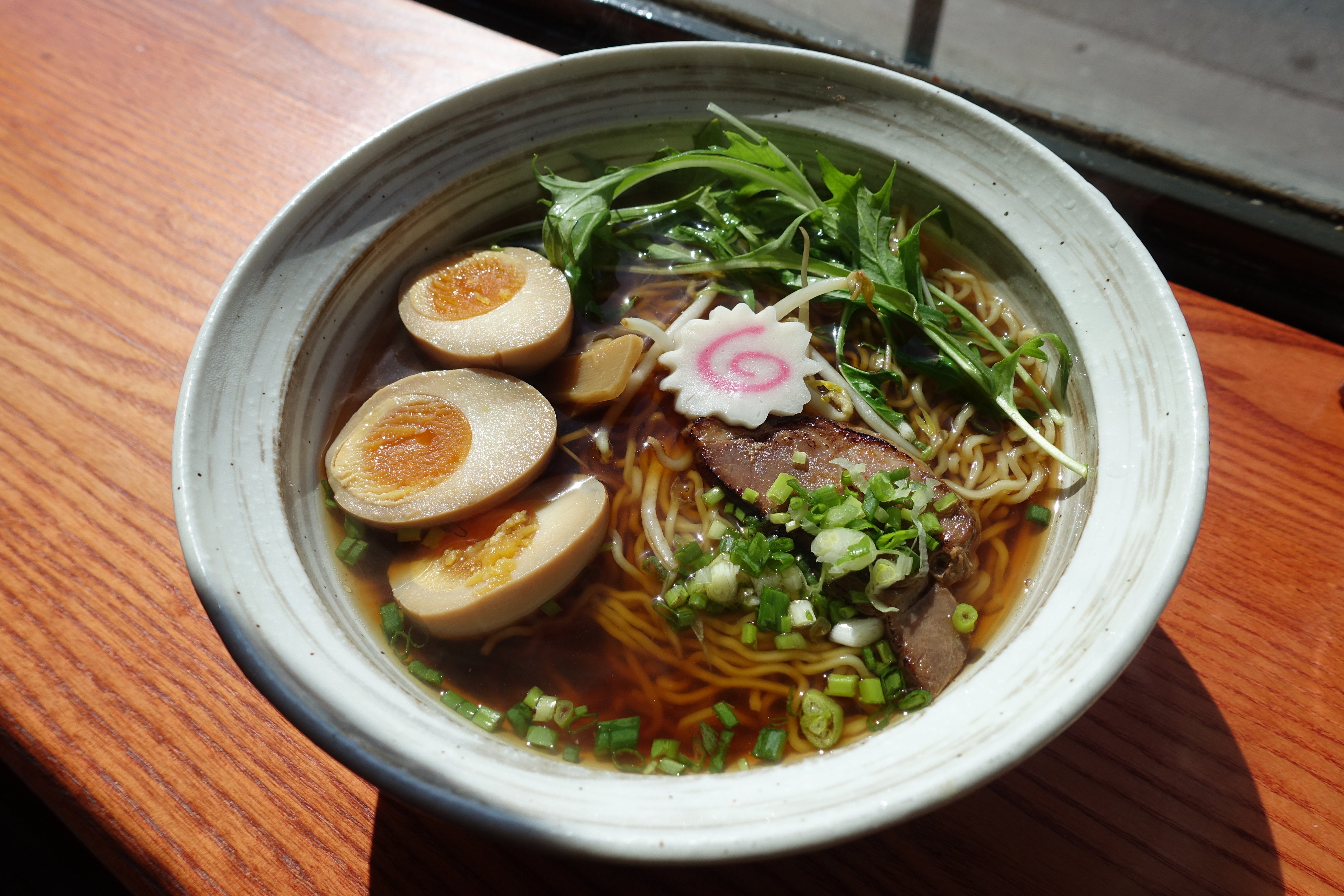|
Sarson's
Sarson's is a brand of malt vinegar brewed in the United Kingdom. It is sold in pear shaped bottles with a flip top and the brand is currently owned by Mizkan. Sarson's also produces vinegar for Sainsbury's, 3663, Chef, Independent and Mizkan. History and uses The vinegar was first brewed by Thomas Sarson in 1794 from malt barley. James Thomas Sarson was a vinegar maker living at Brunswick Place, Shoreditch in 1841. Sales rocketed when his son Henry James Sarson took over. It was renamed "Sarson's Virgin Vinegar" in 1884, referencing a Biblical story of The Wise and Foolish Virgins, by which he was inspired, as opposed to the purity of the product, but this name was soon dropped. In 1893, the company was trading under the name of Henry Sarson and Sons from "The Vinegar Works", Catherine Street, City Road, Shoreditch, London. Two of Henry's sons, Henry Logsdail Sarson and Percival Stanley Sarson also joined the family business as vinegar brewers. The Sarson's Vinegar factory w ... [...More Info...] [...Related Items...] OR: [Wikipedia] [Google] [Baidu] |
Premier Foods
Premier Foods plc is a British food manufacturer headquartered in St Albans, Hertfordshire. The group owns many well-known brands, including Mr Kipling, Ambrosia (food), Ambrosia, Bird's Custard, Angel Delight, Homepride cooking sauces, J. Lyons and Co., Lyons, Sharwood's, Loyd Grossman sauces, Oxo (food), Oxo, Bisto, Batchelors, Vesta meals and Plantastic. Premier Foods also produce cakes under the Cadbury's name, using the brand under licence. It is listed on the London Stock Exchange and is a constituent of the FTSE 250 Index. History Formation The company was founded by Harry Solomon (businessman), Harry Solomon and David Thompson (British businessman), David Thompson in London in 1975 as Hillsdown Holdings. The name came from Thompson's house, Hillsdown. His son Richard Thompson worked for his father after his education at Haileybury and Imperial Service College, Haileybury. In 1981 it acquired ''Lockwood Foods Ltd'' which was in administrative receivership. In May 1987, Dav ... [...More Info...] [...Related Items...] OR: [Wikipedia] [Google] [Baidu] |
Worcester Sauce
Worcestershire sauce or Worcester sauce (UK: ) is a fermented liquid condiment invented by pharmacists John Wheeley Lea and William Henry Perrins in the city of Worcester in Worcestershire, England, during the first half of the 19th century. The inventors went on to form the company Lea & Perrins. Worcestershire sauce has been a generic term since 1876, when the High Court of Justice ruled that Lea & Perrins did not own a trademark for the name "Worcestershire". Worcestershire sauce is used directly as a condiment on steaks, hamburgers, and other finished dishes, and to flavour cocktails such as the Bloody Mary and Caesar. It is also frequently used to augment recipes such as Welsh rarebit, Caesar salad, Oysters Kirkpatrick, and devilled eggs. As both a background flavour and a source of umami (savoury), it is also added to dishes such as beef stew and baked beans. History Fish-based fermented sauces, such as garum, date back to antiquity. In the seventeenth century ... [...More Info...] [...Related Items...] OR: [Wikipedia] [Google] [Baidu] |
Mizkan
is a Japanese company that produces vinegars (including seasoned rice vinegars, balsamic vinegars, and wine vinegars), mustards, salad dressings, authentic East Asian sauces, nattō, and other food products. It is based in Handa, Aichi Prefecture, near Nagoya. History The company was founded in Handa in 1804 by Matazaemon Nakano, who began producing rice vinegar using byproducts from the production of sake (rice alcohol). Nakano named his company the Mitsukan Group. In the late 1970s Mitsukan expanded from Japan into the United States and began acquiring regional condiment companies. The group was officially registered as a corporate entity in July 1977. In 1995, in honour of its founder, the U.S. arm of the business changed its name to Nakano Foods. In 2004, the Mitsukan Group became The Mizkan Group Corporation, and Nakano Foods became Mizkan America. Present Mizkan's product range includes: vinegars, seasoned rice vinegars, balsamic vinegars, wine vinegars, mustards, j ... [...More Info...] [...Related Items...] OR: [Wikipedia] [Google] [Baidu] |
Malt Vinegar
Vinegar () is an aqueous solution of diluted acetic acid and trace compounds that may include flavorings. Vinegar typically contains from 5% to 18% acetic acid by volume. Usually, the acetic acid is produced by a double Fermentation in food processing, fermentation, converting simple sugars to ethanol using yeast and ethanol to acetic acid using acetic acid bacteria. Many types of vinegar are made, depending on source materials. The product is now mainly used in the culinary arts as a flavorful, acidic cooking ingredient or in pickling. Various types are used as condiments or Garnish (cooking), garnishes, including balsamic vinegar and #Grains, malt vinegar. As the most easily manufactured mild acid, it has a wide variety of industrial and domestic uses, including functioning as a Cleaning agent, household cleaner. Etymology The word "vinegar" arrived in Middle English from Old French (''vyn egre''; sour wine), which in turn derives from Latin: (wine) + (neuter gender of , so ... [...More Info...] [...Related Items...] OR: [Wikipedia] [Google] [Baidu] |
Japan
Japan is an island country in East Asia. Located in the Pacific Ocean off the northeast coast of the Asia, Asian mainland, it is bordered on the west by the Sea of Japan and extends from the Sea of Okhotsk in the north to the East China Sea in the south. The Japanese archipelago consists of four major islands—Hokkaido, Honshu, Shikoku, and Kyushu—and List of islands of Japan, thousands of smaller islands, covering . Japan has a population of over 123 million as of 2025, making it the List of countries and dependencies by population, eleventh-most populous country. The capital of Japan and List of cities in Japan, its largest city is Tokyo; the Greater Tokyo Area is the List of largest cities, largest metropolitan area in the world, with more than 37 million inhabitants as of 2024. Japan is divided into 47 Prefectures of Japan, administrative prefectures and List of regions of Japan, eight traditional regions. About three-quarters of Geography of Japan, the countr ... [...More Info...] [...Related Items...] OR: [Wikipedia] [Google] [Baidu] |
British Brands
British may refer to: Peoples, culture, and language * British people, nationals or natives of the United Kingdom, British Overseas Territories and Crown Dependencies. * British national identity, the characteristics of British people and culture * British English, the English language as spoken and written in United Kingdom of Great Britain and Northern Ireland and, more broadly, throughout the British Isles * Celtic Britons, an ancient ethno-linguistic group * Brittonic languages, a branch of the Insular Celtic language family (formerly called British) ** Common Brittonic, an ancient language Other uses *People or things associated with: ** Great Britain, an island ** British Isles, an island group ** United Kingdom, a sovereign state ** British Empire, a historical global colonial empire ** Kingdom of Great Britain (1707–1800) ** United Kingdom of Great Britain and Ireland (1801–1922) * British Raj, colonial India under the British Empire * British Hong Kong, colonial ... [...More Info...] [...Related Items...] OR: [Wikipedia] [Google] [Baidu] |
Brand Name Condiments
A brand is a name, term, design, symbol or any other feature that distinguishes one seller's goods or service from those of other sellers. Brands are used in business, marketing, and advertising for recognition and, importantly, to create and store value as brand equity for the object identified, to the benefit of the brand's customers, its owners and shareholders. Brand names are sometimes distinguished from generic or store brands. The practice of branding—in the original literal sense of marking by burning—is thought to have begun with the ancient Egyptians, who are known to have engaged in livestock branding and branded slaves as early as 2,700 BCE. Branding was used to differentiate one person's cattle from another's by means of a distinctive symbol burned into the animal's skin with a hot branding iron. If a person stole any of the cattle, anyone else who saw the symbol could deduce the actual owner. The term has been extended to mean a strategic personality for a p ... [...More Info...] [...Related Items...] OR: [Wikipedia] [Google] [Baidu] |
British Condiments
British may refer to: Peoples, culture, and language * British people, nationals or natives of the United Kingdom, British Overseas Territories and Crown Dependencies. * British national identity, the characteristics of British people and culture * British English, the English language as spoken and written in United Kingdom of Great Britain and Northern Ireland and, more broadly, throughout the British Isles * Celtic Britons, an ancient ethno-linguistic group * Brittonic languages, a branch of the Insular Celtic language family (formerly called British) ** Common Brittonic, an ancient language Other uses *People or things associated with: ** Great Britain, an island ** British Isles, an island group ** United Kingdom, a sovereign state ** British Empire, a historical global colonial empire ** Kingdom of Great Britain (1707–1800) ** United Kingdom of Great Britain and Ireland (1801–1922) * British Raj, colonial India under the British Empire * British Hong Kong, colonial H ... [...More Info...] [...Related Items...] OR: [Wikipedia] [Google] [Baidu] |
Gravy
Gravy is a sauce made from the juices of meats and vegetables that run naturally during cooking and often thickened with thickeners for added texture. The gravy may be further coloured and flavoured with gravy salt (a mix of salt and caramel food colouring) or gravy browning (gravy salt dissolved in water) or bouillon cubes. Powders can be used as a substitute for natural meat or vegetable extracts. Canned and instant gravies are also available. Gravy is commonly served with roasts, meatloaf, sandwiches, rice, noodles, fries (chips), mashed potatoes, or biscuits (North America, see biscuits and gravy). History One of the earliest recorded mentions of gravy is in a British recipe book entitled " The Forme of Cury", dating from the 14th century. The term gravy originates from the Old French word for meat or fish bouillon, which in fourteenth century French manuscripts was "gravé" or "grané". It is suggested that the French word grané is associated with grain, connect ... [...More Info...] [...Related Items...] OR: [Wikipedia] [Google] [Baidu] |
Soy Sauce
Soy sauce (sometimes called soya sauce in British English) is a liquid condiment of China, Chinese origin, traditionally made from a fermentation (food), fermented paste of soybeans, roasted cereal, grain, brine, and ''Aspergillus oryzae'' or ''Aspergillus sojae'' Mold (fungus), molds. It is recognized for its saltiness and pronounced umami taste. Soy sauce was created in its current form about 2,200 years ago during the Western Han dynasty of ancient China. Since then, it has become an important ingredient in List of Asian cuisines, East and Cuisine of Southeast Asia, Southeast Asian cooking as well as a condiment worldwide. Use and storage Soy sauce can be added directly to food, and is used as a dip or Salt#Edible salt, salt flavor in cooking. It is often eaten with rice, Japanese noodles, noodles, and sushi or sashimi, or can also be mixed with ground wasabi for dipping. Bottles of soy sauce for the salty seasoning of various foods are common on restaurant tables in many co ... [...More Info...] [...Related Items...] OR: [Wikipedia] [Google] [Baidu] |


